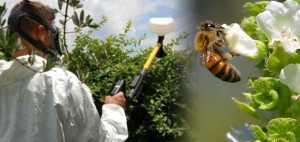Insecticides Are Killing the Pollinators: How Bea-Killing Neonicotinoids Work

Want to understand how bee-killing neonicotinoids (a class of insecticide) work in less than two minutes, and why you should care that the EPA does nothing to reverse the damage that these pesticides have done to our pollinating insects? Watch this brief video that explains it all.
Dr. Keith Tyrell explains how this new class of pesticides, neonicotinoids, which are considered “new” in that they have only been on the market for about 20 years, are taken up by plants as they grow. These ‘neonics’ are not like old pesticides because they become part of the plant itself, making it toxic. (Neonics are taken up by the roots or leaves and taken to all other parts of the plant.)
In fact, they are the fastest growing class of pesticides in the United States. This, even though imidacloprid and acetamiprid – two types of neonics – could possibly be impairing the developing human nervous system.
What’s worse – one study conducted by the U.S. Geological Survey found that neonics are widespread contaminants of groundwater which many people use to drink or bathe in. In nine rivers monitored in the Midwest, where neonics are most heavily used, the study found clothianidin in about three-quarters of monitored sites, thiamethoxam in about one-half, and imidacloprid in about one-quarter
If numerous communities banning neonics due to pollinator-deaths, articles reporting on how the chemicals are killing millions bees, and 100+ organizations urging Obama to take action against the chemicals isn’t enough for the EPA to take action, then I’m not sure what it will take.
If you haven’t yet taken the time to understand neonics, I urge you to take two minutes and do it now.
Follow us: @naturalsociety on Twitter | NaturalSociety on Facebook


